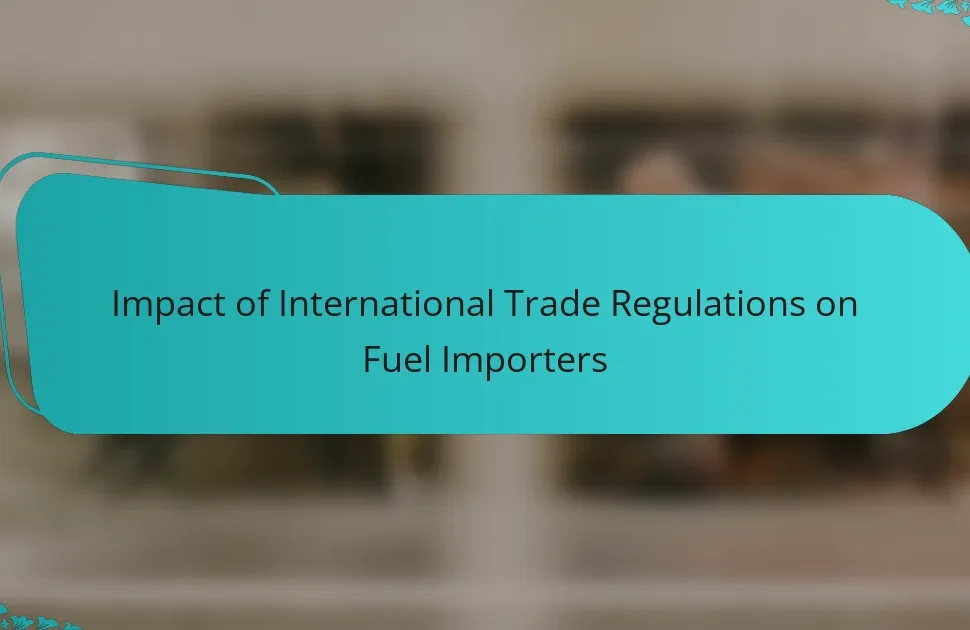
What are Safety Compliance Guidelines for Fuel Storage Facilities?
Safety compliance guidelines for fuel storage facilities include regulations to prevent hazards. Facilities must adhere to local, state, and federal regulations. Proper signage indicating hazardous materials is essential. Regular inspections ensure equipment and storage tanks are in good condition. Spill containment systems must be in place to manage leaks. Personnel should receive training on emergency response procedures. Fire safety measures, including extinguishers and alarms, are mandatory. Documentation of safety protocols and compliance records is required for audits.
Why are Safety Compliance Guidelines important for Fuel Storage Facilities?
Safety compliance guidelines are crucial for fuel storage facilities to prevent accidents and ensure safety. These guidelines help mitigate risks associated with flammable materials. They establish protocols for safe handling, storage, and transportation of fuels. Compliance reduces the likelihood of spills, leaks, and explosions. Regulatory bodies, such as the Environmental Protection Agency (EPA), mandate these guidelines to protect public health and the environment. Adhering to safety standards can also lead to lower insurance costs and enhanced operational efficiency. Facilities that follow these guidelines demonstrate a commitment to safety and regulatory compliance.
What risks are associated with improper fuel storage?
Improper fuel storage poses significant risks, including fire hazards, environmental contamination, and health hazards. Fire hazards arise from fuel vapors igniting due to sparks or heat. Environmental contamination can occur when fuel leaks into soil or water sources. This contamination can harm local ecosystems. Health hazards include exposure to toxic fumes, which can lead to respiratory issues. Additionally, improper storage can result in regulatory non-compliance, leading to legal penalties. According to the National Fire Protection Association, improper storage is a leading cause of fuel-related incidents.
How do compliance guidelines mitigate these risks?
Compliance guidelines mitigate risks in fuel storage facilities by establishing standardized safety protocols. These protocols help identify hazards and implement risk management strategies. They ensure proper handling, storage, and disposal of fuel to prevent spills and accidents. Regular inspections and audits are mandated under these guidelines. This helps maintain compliance and identify potential issues before they escalate. Training requirements for personnel are also outlined in compliance guidelines. This enhances awareness of safety practices among employees. Furthermore, adherence to these guidelines can lead to reduced liability and insurance costs. Statistics show that facilities following compliance guidelines experience fewer incidents and accidents.
What key regulations govern Fuel Storage Facilities?
Key regulations governing fuel storage facilities include the Environmental Protection Agency (EPA) regulations, the Occupational Safety and Health Administration (OSHA) standards, and state-specific regulations. The EPA sets guidelines for underground storage tanks (USTs) under the Resource Conservation and Recovery Act (RCRA). These regulations address leak prevention, reporting, and corrective action. OSHA regulations ensure worker safety during fuel handling and storage. Compliance with the National Fire Protection Association (NFPA) codes is also critical for fire safety. Additionally, local regulations may impose further requirements based on specific environmental or safety concerns. These regulations collectively ensure safe operation and environmental protection for fuel storage facilities.
Which federal agencies are involved in fuel storage regulations?
The federal agencies involved in fuel storage regulations include the Environmental Protection Agency (EPA), the Department of Transportation (DOT), and the Occupational Safety and Health Administration (OSHA). The EPA regulates fuel storage to protect the environment and public health. The DOT oversees the transportation of fuels and related safety measures. OSHA sets safety standards for workers handling fuel storage. These agencies work together to ensure compliance with regulations that promote safety and environmental protection in fuel storage facilities.
What are the state-specific compliance requirements?
State-specific compliance requirements for fuel storage facilities vary by jurisdiction. Each state has its own regulations governing the storage, handling, and disposal of fuel. These regulations often include specific guidelines on tank design, installation, maintenance, and leak detection systems.
For instance, California has stringent requirements under the California Code of Regulations Title 23. New York mandates compliance with the Department of Environmental Conservation regulations. Texas requires adherence to the Texas Administrative Code for fuel storage.
Additionally, states may enforce local ordinances that impose further compliance measures. Facilities must stay updated on these regulations to ensure legal operation and environmental safety.
What are the common safety practices outlined in the guidelines?
Common safety practices outlined in the guidelines include proper labeling of fuel storage containers. This ensures easy identification of contents and hazards. Regular inspections of storage areas are mandated to detect leaks or damage. Personnel must be trained in emergency response procedures specific to fuel spills. Fire safety measures, such as having extinguishers accessible, are essential. Adequate ventilation in storage areas is necessary to prevent the accumulation of flammable vapors. Personal protective equipment (PPE) is required for workers handling fuels. Additionally, maintaining clear access to storage facilities is crucial for emergency services. These practices aim to minimize risks associated with fuel storage and handling.
How should fuel storage tanks be maintained for safety?
Fuel storage tanks should be maintained through regular inspections and proper upkeep. Inspections should occur at least annually to check for leaks, corrosion, and structural integrity. Tanks must be cleaned periodically to remove sludge and contaminants. Proper ventilation is essential to prevent the buildup of explosive vapors. Safety equipment, such as spill containment systems, should be functional and accessible. Emergency response plans must be in place and regularly updated. Training for personnel on safety procedures is crucial for effective maintenance. Following these guidelines minimizes risks associated with fuel storage.
What are the best practices for spill prevention and response?
Best practices for spill prevention and response include regular training, inspection, and maintenance of equipment. Training staff ensures they understand spill response protocols. Routine inspections identify potential leak sources before spills occur. Maintenance of storage tanks and containment systems reduces the risk of spills. Implementing secondary containment systems captures spills effectively. Using spill kits with absorbent materials allows for quick response. Reporting spills immediately ensures proper regulatory compliance. Following these practices minimizes environmental impact and enhances safety.
How can facilities ensure they meet Safety Compliance Guidelines?
Facilities can ensure they meet Safety Compliance Guidelines by implementing a comprehensive safety management system. This system should include regular risk assessments to identify potential hazards. Staff training on safety protocols is essential for compliance. Facilities should also conduct routine inspections to ensure adherence to safety measures. Documentation of compliance efforts is necessary for accountability. Engaging with regulatory agencies can provide guidance on specific requirements. Utilizing safety technology can enhance monitoring and reporting of safety practices. Lastly, continuous improvement processes should be established to adapt to changing regulations and standards.
What training is required for personnel handling fuel storage?
Personnel handling fuel storage must undergo specialized training in hazardous materials management. This training typically includes understanding fuel properties, safety protocols, and emergency response procedures. Personnel learn to identify potential hazards associated with fuel storage. Training also covers proper handling and storage techniques to prevent spills and leaks. Regulatory compliance training is essential to ensure adherence to local and federal regulations. Certification programs may be required, depending on jurisdiction and facility type. Regular refresher courses help maintain knowledge and skills over time. Knowledge of personal protective equipment (PPE) usage is also a critical component of the training.
How can regular audits help maintain compliance?
Regular audits help maintain compliance by systematically evaluating adherence to safety regulations. They identify potential gaps in compliance before they lead to violations. Audits ensure that safety protocols are being followed consistently. They also provide an opportunity to update procedures based on current regulations. Furthermore, regular audits can enhance training programs by highlighting areas needing improvement. According to the National Fire Protection Association, regular inspections can significantly reduce incidents related to fuel storage. This proactive approach minimizes risks and fosters a culture of safety.
What are the consequences of non-compliance with safety guidelines?
Non-compliance with safety guidelines in fuel storage facilities can lead to severe consequences. These consequences include environmental damage, such as soil and water contamination. Financial penalties may be imposed by regulatory agencies for violations. Legal repercussions can arise from lawsuits due to accidents or spills. Additionally, non-compliance can result in operational shutdowns, affecting business continuity. Safety incidents may lead to injuries or fatalities among workers. Insurance premiums may increase as a result of non-compliance risks. Overall, adhering to safety guidelines is crucial to prevent these serious outcomes.
What legal penalties can facilities face for violations?
Facilities can face various legal penalties for violations of safety compliance guidelines. These penalties may include fines, which can range from hundreds to millions of dollars depending on the severity of the violation. In some cases, facilities may be subject to operational shutdowns until compliance is achieved. Additionally, repeated violations can lead to increased scrutiny from regulatory agencies. Facilities may also face criminal charges if violations result in significant harm or negligence. Compliance with safety regulations is enforced by agencies such as the Environmental Protection Agency (EPA) and local authorities. The specific penalties are often outlined in federal and state regulations governing fuel storage safety.
How does non-compliance impact operational efficiency?
Non-compliance negatively impacts operational efficiency by leading to increased downtime and potential penalties. When safety regulations are not followed, operations may be halted for investigations or repairs. This disruption can result in financial losses and decreased productivity. Additionally, non-compliance may lead to legal repercussions, including fines or sanctions. According to the National Safety Council, organizations face an average cost of $1,000 per employee per year due to non-compliance issues. Furthermore, non-compliance can damage a company’s reputation, affecting customer trust and future business opportunities. Overall, adhering to safety compliance guidelines is crucial for maintaining operational efficiency in fuel storage facilities.
What resources are available for understanding and implementing these guidelines?
Resources available for understanding and implementing safety compliance guidelines for fuel storage facilities include government regulations, industry standards, and training programs. The U.S. Environmental Protection Agency (EPA) provides comprehensive guidelines on fuel storage compliance. The National Fire Protection Association (NFPA) offers standards for flammable and combustible liquids. Online courses and webinars from organizations like the American Petroleum Institute (API) can enhance understanding. Additionally, state and local regulatory agencies often publish specific compliance resources. Industry publications and safety manuals also serve as valuable references. These resources collectively aid in ensuring adherence to safety protocols in fuel storage.
Where can facilities find official compliance documentation?
Facilities can find official compliance documentation on government agency websites. Agencies such as the Environmental Protection Agency (EPA) and the Occupational Safety and Health Administration (OSHA) provide essential resources. These websites offer guidelines, regulations, and compliance assistance materials. Additionally, state environmental agencies may have specific documentation relevant to local regulations. Industry associations also publish compliance resources that can be valuable. These sources ensure that facilities have access to up-to-date and accurate compliance information.
What organizations provide support and training for fuel storage safety?
Organizations that provide support and training for fuel storage safety include the National Fire Protection Association (NFPA), the Environmental Protection Agency (EPA), and the Occupational Safety and Health Administration (OSHA). The NFPA offers guidelines and standards for safe fuel storage practices. The EPA provides resources and training related to environmental compliance for fuel storage. OSHA focuses on worker safety and health regulations, including those relevant to fuel storage facilities. These organizations collectively enhance safety protocols and training in the fuel storage industry.
What are some best practices for maintaining safety in Fuel Storage Facilities?
Implementing best practices for maintaining safety in fuel storage facilities includes regular inspections, proper training, and effective emergency response plans. Regular inspections help identify potential hazards, ensuring that equipment and storage tanks are in good condition. Proper training for staff on handling fuel and emergency procedures is essential for minimizing risks. Facilities should also maintain clear labeling of hazardous materials to enhance awareness. Additionally, implementing spill prevention measures, such as secondary containment systems, reduces the risk of environmental contamination. Fire safety measures, including proper ventilation and fire suppression systems, are critical. Following local regulations and industry standards further enhances safety compliance. These practices collectively help mitigate risks associated with fuel storage.
Safety compliance guidelines for fuel storage facilities are critical regulations designed to prevent hazards associated with fuel storage, including fire risks and environmental contamination. The article outlines the importance of adhering to local, state, and federal regulations, detailing key practices such as proper signage, regular inspections, and emergency response training. It discusses the risks of improper fuel storage, the role of federal agencies like the EPA and OSHA in enforcing compliance, and the consequences of non-compliance, including legal penalties and operational inefficiencies. Additionally, it provides resources and best practices for maintaining safety and compliance in fuel storage operations.




